Hãy nhập câu hỏi của bạn vào đây, nếu là tài khoản VIP, bạn sẽ được ưu tiên trả lời.

e: \(\left\{{}\begin{matrix}\dfrac{1}{x}-\dfrac{1}{y}=1\\\dfrac{3}{x}+\dfrac{4}{y}=5\end{matrix}\right.\Leftrightarrow\left\{{}\begin{matrix}\dfrac{3}{x}-\dfrac{3}{y}=3\\\dfrac{3}{x}+\dfrac{4}{y}=5\end{matrix}\right.\)
\(\Leftrightarrow\left\{{}\begin{matrix}\dfrac{-7}{y}=-2\\\dfrac{1}{x}-\dfrac{1}{y}=1\end{matrix}\right.\Leftrightarrow\left\{{}\begin{matrix}y=\dfrac{7}{2}\\\dfrac{1}{x}=1+\dfrac{2}{7}=\dfrac{9}{7}\end{matrix}\right.\Leftrightarrow\left\{{}\begin{matrix}y=\dfrac{7}{2}\\x=\dfrac{7}{9}\end{matrix}\right.\)

c) \(\left\{{}\begin{matrix}2\left(x-2\right)+3\left(1+y\right)=2\\3\left(x-2\right)-2\left(1+y\right)=-3\end{matrix}\right.\)
\(\Leftrightarrow\left\{{}\begin{matrix}6\left(x-2\right)+9\left(1+y\right)=6\\6\left(x-2\right)-4\left(1+y\right)=-6\end{matrix}\right.\)
\(\Leftrightarrow\left\{{}\begin{matrix}13\left(1+y\right)=12\\2\left(x-2\right)+3\left(1+y\right)=2\end{matrix}\right.\)
\(\Leftrightarrow\left\{{}\begin{matrix}x=\dfrac{21}{13}\\y=-\dfrac{1}{13}\end{matrix}\right.\)
d) \(\left\{{}\begin{matrix}\left(x-5\right)\left(y-2\right)=\left(x+2\right)\left(y-1\right)\\\left(x-4\right)\left(y+7\right)=\left(x-3\right)\left(y+4\right)\end{matrix}\right.\)
\(\Leftrightarrow\left\{{}\begin{matrix}xy-2x-5y+10=xy-x+2y-2\\xy+7x-4y-28=xy+4x-3y-12\end{matrix}\right.\)
\(\Leftrightarrow\left\{{}\begin{matrix}-x-7y=-12\\3x-y=16\end{matrix}\right.\) \(\Leftrightarrow\left\{{}\begin{matrix}-x-7y=-12\\21x-7y=112\end{matrix}\right.\)
\(\Leftrightarrow\left\{{}\begin{matrix}22x=124\\3x-y=16\end{matrix}\right.\) \(\Leftrightarrow\left\{{}\begin{matrix}x=\dfrac{62}{11}\\y=\dfrac{10}{11}\end{matrix}\right.\)

a: \(\left\{{}\begin{matrix}x+4y=-11\\5x-4y=1\end{matrix}\right.\Leftrightarrow\left\{{}\begin{matrix}6x=-10\\x+4y=-11\end{matrix}\right.\Leftrightarrow\left\{{}\begin{matrix}x=\dfrac{-5}{3}\\y=\dfrac{-11-x}{4}=\dfrac{-11+\dfrac{5}{3}}{4}=-\dfrac{7}{3}\end{matrix}\right.\)
b: \(\left\{{}\begin{matrix}2x-y=7\\3x+5y=-22\end{matrix}\right.\Leftrightarrow\left\{{}\begin{matrix}6x-3y=21\\6x+15y=-66\end{matrix}\right.\)
\(\Leftrightarrow\left\{{}\begin{matrix}-18y=78\\2x-y=7\end{matrix}\right.\Leftrightarrow\left\{{}\begin{matrix}y=\dfrac{-13}{3}\\x=\dfrac{y+7}{2}=\dfrac{4}{3}\end{matrix}\right.\)

\(\left\{{}\begin{matrix}\left(x-5\right)\left(y-2\right)=\left(x+2\right)\left(y-1\right)\\\left(x-4\right)\left(y+7\right)=\left(x-3\right)\left(y+4\right)\end{matrix}\right.\)
\(\Leftrightarrow\left\{{}\begin{matrix}xy-2x-5y+10=xy-x+2y-2\\xy+7x-4y-28=xy+4x-3y-12\end{matrix}\right.\)
\(\Leftrightarrow\left\{{}\begin{matrix}x+7y=12\\3x-y=16\end{matrix}\right.\) \(\Leftrightarrow\left\{{}\begin{matrix}3x+21y=36\\3x-y=16\end{matrix}\right.\)
\(\Leftrightarrow\left\{{}\begin{matrix}22y=20\\x+7y=12\end{matrix}\right.\) \(\Leftrightarrow\left\{{}\begin{matrix}x=\dfrac{62}{11}\\y=\dfrac{10}{11}\end{matrix}\right.\)

Bài toán này có hai cách giải:
Cách 1: Thu gọn từng phương trình ta sẽ thu được phương trình bậc nhất hai ẩn x và y.
Cách 2: Đặt ẩn phụ.
Cách 1:

 (hệ số của y bằng nhau nên ta trừ từng vế hai phương trình)
(hệ số của y bằng nhau nên ta trừ từng vế hai phương trình)
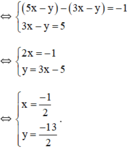
Vậy hệ phương trình có nghiệm duy nhất 
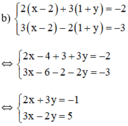
(Nhân hai vế pt 1 với 2; pt 2 với 3 để hệ số của y đối nhau)
 (Hệ số của y đối nhau nên ta cộng từng vế của hai pt)
(Hệ số của y đối nhau nên ta cộng từng vế của hai pt)
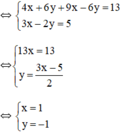
Vậy hệ phương trình có nghiệm duy nhất (1; -1).
Cách 2:
a) Đặt x + y = u và x – y = v (*)
Khi đó hệ phương trình trở thành
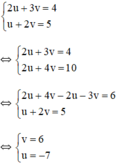
Thay u = -7 và v = 6 vào (*) ta được hệ phương trình:
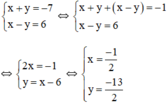
Vậy hệ phương trình có nghiệm 
b) Đặt x – 2 = u và y + 1 = v.
Khi đó hệ phương trình trở thành :
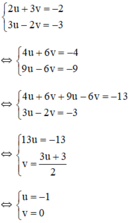
+ u = -1 ⇒ x – 2 = -1 ⇒ x = 1.
+ v = 0 ⇒ y + 1 = 0 ⇒ y = -1.
Vậy hệ phương trình có nghiệm (1; -1).

\(a.\left\{{}\begin{matrix}\dfrac{1}{x}-\dfrac{1}{y}-2=-1\\\dfrac{4}{x}+\dfrac{3}{y}-2=5\end{matrix}\right.\)\(\Leftrightarrow\left\{{}\begin{matrix}a-b-2=-1\\4a+3b-2=5\end{matrix}\right.\) (với \(\dfrac{1}{x}=a-\dfrac{1}{y}=b\))
\(\Leftrightarrow\left\{{}\begin{matrix}a=\dfrac{10}{7}\\b=\dfrac{3}{7}\end{matrix}\right.\)\(\Leftrightarrow\left\{{}\begin{matrix}\dfrac{1}{x}=\dfrac{10}{7}\Rightarrow x=\dfrac{7}{10}\\\dfrac{1}{y}=\dfrac{3}{7}\Rightarrow y=\dfrac{7}{3}\end{matrix}\right.\)
\(b.\left\{{}\begin{matrix}\dfrac{2}{x}+\dfrac{5}{\left(x+y\right)}=2\\\dfrac{3}{x}+\dfrac{1}{\left(x+y\right)}=\dfrac{17}{10}\end{matrix}\right.\)\(\Leftrightarrow\left\{{}\begin{matrix}2a+5b=2\\3a+b=\dfrac{17}{10}\end{matrix}\right.\) (với \(\dfrac{1}{x}=a-\dfrac{1}{x+y}=b\))
\(\Leftrightarrow\left\{{}\begin{matrix}a=\dfrac{1}{2}\\b=\dfrac{1}{5}\end{matrix}\right.\)\(\Leftrightarrow\left\{{}\begin{matrix}\dfrac{1}{x}=\dfrac{1}{2}\Rightarrow x=2\\\dfrac{1}{x+y}=\dfrac{1}{5}\Rightarrow y=3\end{matrix}\right.\)
\(c.\left\{{}\begin{matrix}\dfrac{2}{x-1}+\dfrac{1}{y+1}=7\\\dfrac{5}{x-1}-\dfrac{2}{y+1}=4\end{matrix}\right.\Leftrightarrow\left\{{}\begin{matrix}2a+b=7\\5a-2b=4\end{matrix}\right.\) (với \(\dfrac{1}{x-1}=a-\dfrac{1}{y+1}=b\))
\(\Leftrightarrow\left\{{}\begin{matrix}a=2\\b=3\end{matrix}\right.\)\(\Leftrightarrow\left\{{}\begin{matrix}\dfrac{1}{x-1}=2\Rightarrow x=\dfrac{3}{2}\\\dfrac{1}{y+1}=3\Rightarrow y=-\dfrac{2}{3}\end{matrix}\right.\)
\(d.\left\{{}\begin{matrix}\dfrac{2}{\sqrt{x-1}}-\dfrac{1}{\sqrt{y-1}}=1\\\dfrac{1}{\sqrt{x-1}}+\dfrac{1}{\sqrt{y-1}}=2\end{matrix}\right.\Leftrightarrow\left\{{}\begin{matrix}2a-b=1\\a+b=2\end{matrix}\right.\) (với \(\dfrac{1}{\sqrt{x-1}}=a-\dfrac{1}{\sqrt{y-1}}=b\))
\(\Leftrightarrow\left\{{}\begin{matrix}a=1\\b=1\end{matrix}\right.\)\(\Leftrightarrow\left\{{}\begin{matrix}\dfrac{1}{\sqrt{x-1}}=1\Rightarrow x=2\\\dfrac{1}{\sqrt{y-1}}=1\Rightarrow y=2\end{matrix}\right.\)

Lấy phương trình (2) trừ phương trình (1), vế trừ vế ta được:
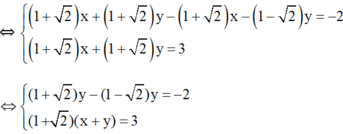
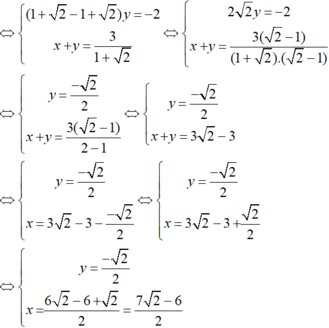
Vậy hệ phương trình có nghiệm duy nhất 
Lưu ý:

Kiến thức áp dụng
Giải hệ phương trình bằng phương pháp cộng đại số
1) Nhân hai vế của phương trình với mỗi hệ số thích hợp (nếu cần) sao cho hệ số của một trong hai ẩn bằng nhau hoặc đối nhau.
2) Áp dụng quy tắc cộng đại số để được hệ phương trình mới, trong đó có một phương trình mà hệ số của một trong hai ẩn bằng 0 (tức là phương trình một ẩn).
3) Giải phương trình một ẩn vừa thu được rồi suy ra nghiệm của hệ đã cho và kết luận.

a) Ta có: \(\left\{{}\begin{matrix}\dfrac{5}{x-1}+\dfrac{1}{y-1}=10\\\dfrac{1}{x-1}-\dfrac{3}{y-1}=18\end{matrix}\right.\)
\(\Leftrightarrow\left\{{}\begin{matrix}\dfrac{5}{x-1}+\dfrac{1}{y-1}=10\\\dfrac{5}{x-1}-\dfrac{15}{y-1}=90\end{matrix}\right.\Leftrightarrow\left\{{}\begin{matrix}\dfrac{16}{y-1}=-80\\\dfrac{1}{x-1}-\dfrac{3}{y-1}=18\end{matrix}\right.\)
\(\Leftrightarrow\left\{{}\begin{matrix}y-1=\dfrac{-1}{5}\\\dfrac{1}{x-1}=18+\dfrac{3}{y-1}=3\end{matrix}\right.\Leftrightarrow\left\{{}\begin{matrix}y=\dfrac{4}{5}\\x-1=\dfrac{1}{3}\end{matrix}\right.\)
\(\Leftrightarrow\left\{{}\begin{matrix}x=\dfrac{4}{3}\\y=\dfrac{4}{5}\end{matrix}\right.\)
Từ (1) rút ra được: (*)
(*)
Thay (*) vào phương trình (2) ta được:
Thay vào (*) ta được:
vào (*) ta được:
Vậy hệ phương trình có nghiệm
b) Điều kiện xác định: x ≠ -1; y ≠ -1.
Đặt , hệ phương trình trở thành:
, hệ phương trình trở thành:
Vậy hệ phương trình có nghiệm a
a